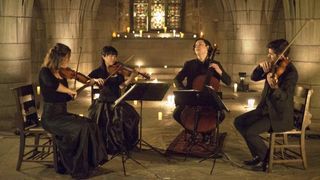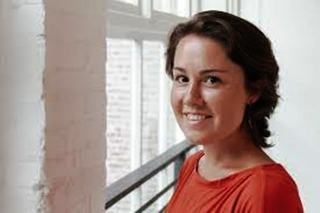|
Back
The Singularity of Bliss New York
Crypt in Church of the Intercession
04/30/2019 -
Caroline Shaw: Entr’acte – Punctum – Plan & Elevation – Blueprint – Ritornello – Valencia
Attacca Quartet: Amy Schroeder, Keiko Tokunaga (Violins), Nathan Schram (Viola), Andrew Yee (Cello)

The Attacca Quartet at Church of the Intercession
(© Andrew Ousley/Tristan Cook)
“I guess I'd like people to be able to forget a lot of things and just enjoy the beauty of harmony and melody for a moment.”
Caroline Shaw (1982–)
The effervescence of harmonies, melodies and delicious diversions last night in an all-Caroline Shaw concert was so consuming that only afterwards did non-Shaw ideas occur.
First, a far-flung resemblance to the music of Spectralist Gérard Grisey heard the preceding night. Not the metaphysical meta-musical intimations. But that both composers begin their works with ordinary melodies, often from other composers, and unravel fantastic fantasias from those initial notes.
Second, Ms. Shaw is very much the product of traditional North Carolina music. Greenville is a town, but around Greenville are mountains which encourage Gospel, blues, and Anglo-Saxon tunes going back four centuries. Like the later Béla Bartók, Ms. Shaw can incorporate that spiritual heritage without have to quote directly. Which is quite a trick!
A corollary. That the genius of Aaron Copland allowed him to beautifully manufacture American “folk”. Ms. Shaw’s genius is organic,springing from something which needs neither research nor artifice.
Third–more to the program last night, held deep in the catacombs of the Church of the Intercession–one heard the difference between the inspirations of performers. Specifically, last week I heard a technically excellent string quartet play Ms. Shaw’s Entr’acte, and wrote that, while entranced, I couldn’t quite get it, that I needed another hearing.
Last night, the Attacca String Quartet played the same work, and I needed nothing else. True to their name, this young group played Entr’acte with more than precision: it was attacked with electricity, with unashamed respect for the different parts rather than attempting to make it a unitary whole. And the surprises of Ms. Shaw’s divergency were so immediate that one never wondered about structure or reason. The sounds were their own reward.
Then again, Andrew Ousley’s promotion of crypts and catacombs as musical venues does give an original auditory feeling. Attacca obviously doesn’t need to play with as much pressure to ascertain that their music be heard. In these catacombs, the glory of Beethoven or Shaw can resonate even to the dead!
(An incidental note of approval. Caroline Shaw’s six pieces were recently recorded by the Attacca. Any other promoter would have offered the CDs after the performance. Not here. Ms. Ousley, like his musicians, is a class act.)
Back to Ms. Shaw. An hour’s worth of unfamiliar string quartet music could be a chore. And while I had heard it before, in National Sawdust three years ago, this music was never a reiteration. Rather, hers is the music of ebullience. And enthusiasm.
And let us not forget that Ms. Shaw–who prefers the term “musician” to “composer”–is an experienced string-quartet player herself. Thus, her dazzling fiddle-tricks don’t stand out, they are part of the fabric. She can use quarter-tonal measures and one loves the music (not “those strange sounds”). Her intricate counterpoint of pizzicatos is not to show off her players, but as a divergence from an already flower-filled forest path. When bows brush against strings, it’s like a whisper. (Like Sondheim’s “Say it soft, and it’s just like praying”).
She may begin her Entr’acte with a theme from a Haydn string quartet, and, while this returns several times, it is neither rondo nor variation. We trot with her down that bridle path, gazing at a multitude of orchids and oak trees, turn to a chasm, get back to the Haydn path again and wait for the next divergence.
In Punctum, we hear parts of Bach’s St. Matthew’s Passion, yet Ms. Shaw never delves into the liturgical. Punctum again has a secular youthfulness.

C. Shaw
Plan & Elevation has a program of sorts, the different movements referring to different spots of beauty. She begins with a lachrymose Three Blind Mice tune from violinist Amy Schroeder, those notes are heard later in retrograde, though one never thinks “Aha! A three-note tone row!”. Rather the notes bloom, organically with all four players encouraging different configurations, thoughts, reveries and revelries.
Her fantasias continued on tones with Ritornello, and one didn’t need to know that the foundation was from Monteverdi’s Orfeo, or that Blueprint came from Beethoven.
All this music reflected what I once heard Elliott Carter say about Mozart string quartets. That the Classical structures were a framework, but that Mozart changed, augmented, dropped in whatever sounded nice to his infallible ear.
The final piece was Valencia, which did not refer to the city (gorgeous itself), the song (faux-Iberian). Ms. Shaw is less sensuous than tactile. And Valencia possessed only remote shadows of Spain. It referred to eating a store-bought orange! The taste, the juiciness, the haptic sheer pleasure.
One more word on the Attacca. These are not faceless technicians. The earnest Amy Schroeder, the silent amusement of Keiko Tokunaga, the scholarly visage of cellist Nathan Schram, and–above all–the physical high-spirits of cellist Andrew Yee, added up to a singular performance. Caroline Shaw’s demands this singularity for her inspirations of personal bliss.
Harry Rolnick
|